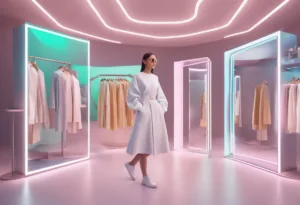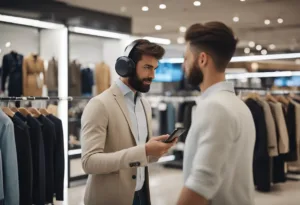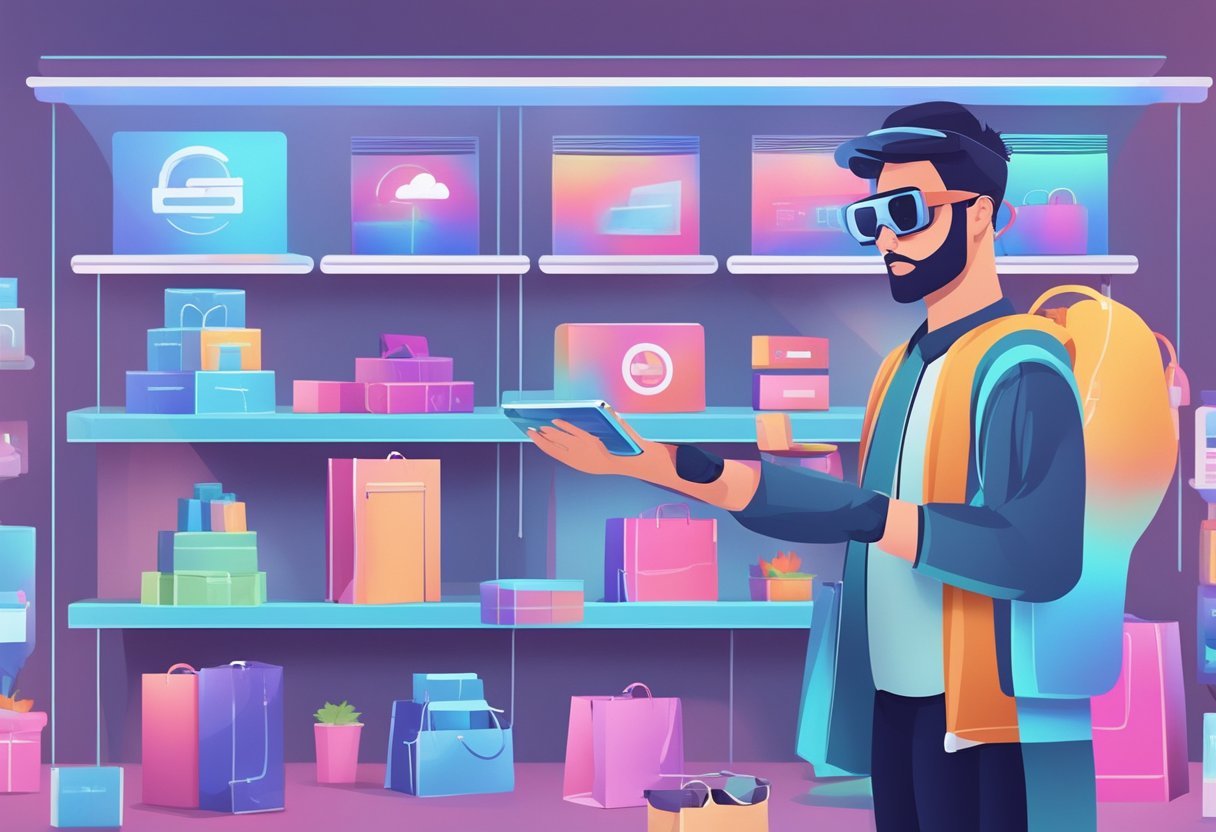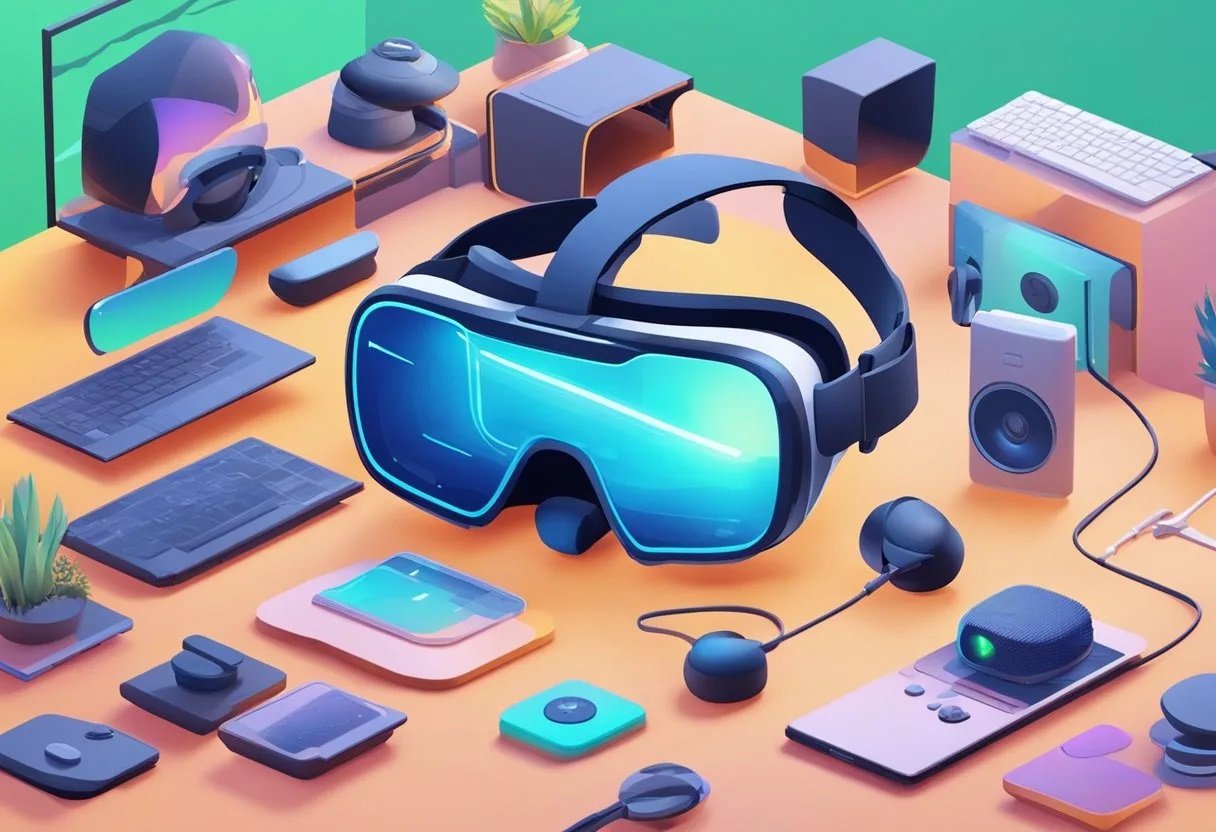Augmented reality (AR) is a technology that overlays digital information onto the physical world. In recent years, AR has gained popularity in the retail industry as a way to enhance the shopping experience. By using AR, retailers can create immersive and interactive experiences for their customers, both online and in-store. In this blog post, I will discuss with you the evolution of augmented reality for shopping and how this technology is changing shopping
One of the main benefits of AR in shopping is the ability to visualize products in a realistic way. With AR, customers can see how furniture, clothing, or makeup would look in their home or on their face before making a purchase. This not only improves the customer experience but also reduces the likelihood of returns. AR can provide customers with more information about products, such as reviews, specifications, and pricing, all in real-time.
AR is also transforming online shopping by bringing the in-store experience to the digital world. By using AR, retailers can create virtual try-on experiences, allowing customers to see how clothing or makeup would look on them without physically trying them on. This can increase customer engagement and lead to higher conversion rates. Overall, AR is a technology that is changing the way we shop, and it is likely to become even more prevalent in the future as retailers continue to adopt it to improve the customer experience.
Evolution of Shopping: From Physical Stores to Augmented Reality
The world of shopping has undergone a significant transformation in recent years. The rise of e-commerce and the impact of the COVID-19 pandemic have led to a shift in consumer behavior towards online shopping. As a result, retailers have been forced to adapt to changing consumer preferences, and this has led to the emergence of new technologies such as augmented reality (AR) in retail.
Rise of E-Commerce and the Pandemic’s Impact
The COVID-19 pandemic has accelerated the adoption of e-commerce, with more consumers turning to online shopping as a safer alternative to physical stores. This has led to a significant increase in online sales, with retailers investing heavily in their online presence to meet the growing demand. However, the shift to online shopping has also highlighted the limitations of traditional e-commerce, such as the inability to try on clothes or see products in person.
The Advent of AR in Retail
AR technology has the potential to bridge the gap between physical and online shopping by allowing consumers to experience products in a virtual environment. With the help of a smartphone or tablet, consumers can use AR to visualize products in real-world settings, try on virtual clothes, and even see how furniture would look in their homes. This technology has the potential to revolutionize the way consumers shop and has already been adopted by several retailers.
The rise of e-commerce and the impact of the COVID-19 pandemic have led to a shift in consumer behavior towards online shopping. This has led to the emergence of new technologies such as augmented reality in retail, which has the potential to revolutionize the way consumers shop. As retailers continue to invest in new technologies, it is likely that we will see further advancements in the world of shopping in the years to come.
How Augmented Reality Enhances the Shopping Experience

Augmented Reality (AR) technology has revolutionized the shopping experience. By integrating virtual elements into the real world, AR has opened up new possibilities for the retail industry. Here are some of the ways AR enhances the shopping experience:
Virtual Try-On Technology
One of the most significant advantages of AR technology is the ability to try on clothes virtually. AR-powered virtual try-on technology allows shoppers to see how clothes fit on their body without physically trying them on. This technology is especially useful for online shopping, where customers cannot physically try on clothes before making a purchase. Virtual try-on technology also allows shoppers to experiment with different styles, colors, and textures, enhancing the overall shopping experience.
Interactive Product Previews
AR technology also enables interactive product previews, allowing customers to see products in 3D and from different angles. This technology is particularly useful for furniture shopping, where customers can see how furniture fits in their space before making a purchase. Interactive product previews also allow customers to see the product’s size, color, and texture, providing a more detailed and intuitive product information than standard web experiences.
Personalization and Customization
AR technology also enables personalization and customization, allowing customers to tailor products to their preferences. For example, makeup brands can use AR technology to create personalized makeup looks based on a customer’s skin tone, face shape, and desired style. AR technology also allows customers to customize furniture by changing the color, size, and style, providing a more personalized shopping experience.
AR technology has transformed the shopping experience by providing virtual try-on technology, interactive product previews, and personalization and customization. It has enabled customers to try on clothes virtually, see products in 3D, and tailor products to their preferences, enhancing the overall shopping experience.
Implementation of AR in Various Retail Sectors

The implementation of Augmented Reality (AR) in the retail industry has been a game-changer for many businesses. AR technology has provided retailers with an opportunity to enhance the shopping experience of their customers by allowing them to visualize products in a more immersive way. This section will explore the implementation of AR in various retail sectors.
Fashion and Apparel
AR technology has been widely adopted in the fashion and apparel industry. Retailers such as Nike have implemented AR technology to create interactive shopping experiences for their customers. Nike’s AR technology allows customers to try on shoes virtually, and see how they look on their feet before making a purchase. This technology has increased customer engagement and has led to a rise in sales for the company.
Furniture and Home Decor
AR technology has also been implemented in the furniture and home decor industry. Companies such as IKEA have implemented AR technology to allow customers to visualize furniture in their homes before making a purchase. This technology has helped customers to make more informed decisions when buying furniture and has reduced the number of returns for the company.
Beauty and Cosmetics
AR technology has also been implemented in the beauty and cosmetics industry. Retailers such as Sephora have implemented AR technology to allow customers to try on makeup virtually. This technology has helped customers to see how different makeup products look on their skin before making a purchase. This has resulted in an increase in customer satisfaction and has led to a rise in sales for the company.
The implementation of AR technology has been a game-changer for many retailers. AR technology has allowed retailers to provide their customers with a more immersive shopping experience and has increased customer engagement. The implementation of AR technology in various retail sectors such as fashion and apparel, furniture and home decor, and beauty and cosmetics has led to a rise in sales and customer satisfaction.
The Business Impact of AR on Retail

Augmented Reality (AR) is revolutionizing the retail sector, providing a new way for retailers to engage with their customers. AR technology offers an immersive shopping experience, enabling customers to visualize products in a virtual environment before making a purchase. This section explores the impact of AR on retail business, specifically focusing on conversion rates and sales growth, as well as enhancing brand loyalty and customer engagement.
Conversion Rates and Sales Growth
AR technology has been shown to have a significant impact on conversion rates and sales growth. According to a recent study, the use of AR in retail can increase conversion rates by up to 90%. AR technology enables customers to visualize products in a virtual environment, allowing them to make more informed purchasing decisions. This leads to a higher likelihood of customers making a purchase, resulting in increased sales for retailers.
In addition to increasing conversion rates, AR technology can also lead to increased revenue for retailers. By providing customers with an immersive shopping experience, retailers can differentiate themselves from their competitors and attract more customers. This can lead to increased sales and revenue growth for retailers.
Enhancing Brand Loyalty and Customer Engagement
AR technology can also enhance brand loyalty and customer engagement. By providing customers with an immersive shopping experience, retailers can create a more emotional connection with their customers. This emotional connection can lead to increased brand loyalty and customer retention.
AR technology also enables retailers to provide a more personalized shopping experience for their customers. By allowing customers to visualize products in a virtual environment, retailers can tailor their offerings to the preferences of individual customers. This can lead to increased customer satisfaction and loyalty.
AR technology has a significant impact on the retail sector, providing a new way for retailers to engage with their customers. By increasing conversion rates and sales growth, as well as enhancing brand loyalty and customer engagement, AR technology is transforming the way retailers do business.
Future Trends and Developments in AR Shopping
As technology continues to advance, the future of augmented reality (AR) in shopping looks bright. With the rise of Gen Z and the increasing global population of smartphone users, AR technology is expected to become even more popular in the coming years. In this section, we will discuss some of the future trends and developments in AR shopping.
Advancements in AR Technology
One of the most significant future trends in AR shopping is the development of more advanced AR technology. The current AR technology is already impressive, but there is still room for improvement. In the future, AR technology is expected to become more advanced, with better graphics, faster processing speeds, and more accurate tracking.
As AR technology continues to advance, it is expected to become more widely adopted by retailers. This will lead to an increase in the number of AR shopping experiences available to consumers. In addition, the cost of AR technology is expected to decrease, making it more accessible to retailers of all sizes.
The Role of Social Media and Influencers
Social media platforms like Instagram and Snapchat have already played a significant role in the rise of AR shopping. In the future, social media is expected to continue to play a crucial role in the development of AR shopping experiences.
One trend that is expected to continue is the use of social media influencers to promote AR shopping experiences. Influencers can help to increase consumer awareness of AR shopping experiences and drive more traffic to retailers’ websites.
In addition, social media platforms are expected to continue to develop their AR capabilities. For example, Snapchat has already launched a range of AR shopping experiences, and it is likely that other social media platforms will follow suit.
The future of AR shopping looks bright. With advancements in AR technology and the continued development of social media platforms, we can expect to see more and more retailers adopting AR shopping experiences in the coming years.
Challenges and Considerations for Retailers
Augmented Reality (AR) technology can provide a unique shopping experience for customers, but it also poses challenges and considerations for retailers.
Integration with Existing Systems
One of the challenges retailers face when implementing AR technology into their stores is integrating it with their existing systems. Retailers need to ensure that AR technology works seamlessly with their supply chain, inventory management, and other backend systems. This requires a significant investment in time and resources to ensure that the technology is integrated correctly.
Creating Quality 3D Content
Another challenge retailers face when implementing AR technology is creating quality 3D content. To create an immersive shopping experience, retailers need to have high-quality 3D assets of their products. This requires specialized skills and tools to create 3D models that are both accurate and visually appealing. Retailers also need to ensure that the 3D models are optimized for AR devices to ensure a smooth and seamless experience for customers.
User Experience and Accessibility
Retailers also need to consider the user experience and accessibility of AR technology. For example, not all customers may have access to the latest smartphones or tablets required to use AR technology. Retailers need to ensure that their AR experiences are accessible to as many customers as possible.
Retailers need to ensure that their AR experiences are user-friendly and intuitive to use. This requires a significant investment in user experience design and testing to ensure that customers can easily interact with the AR technology.
While AR technology can provide a unique shopping experience for customers, retailers need to carefully consider the challenges and considerations associated with implementing this technology. Retailers need to invest in integrating AR technology with their existing systems, creating quality 3D content, and designing user-friendly and accessible experiences to ensure that customers can interact with AR technology in a convenient and enjoyable way.
Frequently Asked Questions

How do retailers incorporate augmented reality to enhance the shopping experience?
Retailers incorporate augmented reality (AR) into their shopping platforms to enhance the customer experience. AR technology allows customers to visualize products in a more realistic way before making a purchase. Retailers can use AR to create virtual fitting rooms, which allow customers to try on clothes without physically trying them on. They can also use AR to create virtual showrooms, which allow customers to see how furniture or home decor would look in their homes. By using AR, retailers can provide a more personalized and immersive shopping experience.
What are some notable examples of augmented reality in e-commerce?
Some notable examples of augmented reality in e-commerce include:
- IKEA Place: An app that allows customers to see how furniture would look in their homes before making a purchase.
- Sephora Virtual Artist: An app that allows customers to try on makeup virtually.
- Warby Parker Virtual Try-On: An app that allows customers to try on glasses virtually.
What companies have successfully integrated AR into their shopping platforms?
Several companies have successfully integrated AR into their shopping platforms. Some of these companies include:
- IKEA
- Sephora
- Warby Parker
- Walmart
- Amazon
What are the benefits of using augmented reality for both shoppers and retailers?
Using augmented reality provides several benefits for both shoppers and retailers. For shoppers, AR allows them to visualize products in a more realistic way before making a purchase. This can lead to increased satisfaction with the product and a decreased likelihood of returns. For retailers, AR can lead to increased sales and decreased costs associated with returns. AR can provide a more personalized and immersive shopping experience, which can lead to increased customer loyalty.
How has Walmart implemented augmented reality to improve customer shopping?
Walmart has implemented augmented reality in several ways to improve the customer shopping experience. One example is the use of AR in their app to help customers find products in-store. Another example is the use of AR to create virtual showrooms, which allow customers to see how furniture or home decor would look in their homes before making a purchase. By using AR, Walmart is able to provide a more personalized and immersive shopping experience for their customers.
In what ways can augmented reality lead to increased sales for stores?
Augmented reality can lead to increased sales for stores in several ways. By allowing customers to visualize products in a more realistic way, AR can lead to increased satisfaction with the product and a decreased likelihood of returns. AR can provide a more personalized and immersive shopping experience, which can lead to increased customer loyalty. Finally, by using AR to create virtual showrooms or fitting rooms, stores can provide a more convenient and efficient shopping experience, which can lead to increased sales.




